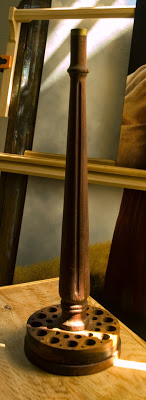An old black piano leg and two wall plaques
By Al R. Young
Sometimes the creative process seems to backfire, even though no signs of difficulty appear along the way. One such occurrence involved my desire to create a brush holder out of an old black piano leg and two wall plaques.
When I stepped into the shop to embark on the project, I simply wanted to make a brush holder that would accommodate as many brushes as I might use during a long and demanding painting session, and I had nothing more than a hunch that the piano leg--that had been in one of the scrap buckets long enough for me to despair of finding a good use for it--would be a good place to start. As I worked with it, ideas flowed, the woodworking progressed well, and voila I found myself the astonished owner of one of the most outlandish brush holders I had ever seen or imagined.
I'm one of those people who, generally, has to create the thing in order to see it, instead of seeing it in order to create it.1 It usually turns out that even though I may be somewhat surprised by an outcome, I'm neither disappointed nor discouraged, but a table-top brush holder with a 2 ft. tall spindle on it for a handle (and the top of the spindle sporting a small brass wheel) was a bit too much. I couldn't help but think of the floor lamp in A Christmas Story by Jean Shepherd. Early on, I decided to remove the brass caster, and that helped dissolve the association with the floor lamp; nevertheless, I still wondered what I had been the means of creating.
Since then, the brush holder has become not only a workhorse accessory in the studio, but my favorite for carting brushes around, particularly between floors -- a consideration that was unimportant until the work of the studio occupied three stories. In other words, the brush holder was an artifact from a new paradigm. It belonged to a studio that had not yet materialized, to work patterns and needs not yet present.
1 Creation Myths by Marie-Louise von Franz (London: Shambhala Publications, 1995). My reading journal for this source includes the following commentary:
On pp. 66 - 72, the author distinguishes creative stimuli coming from above as opposed to arising from beneath One of the chief characteristics of such impulses and ideas coming from above appears, in the author's view, to involve the presentation via the subconscious of a more or less complete idea. For example, to an artist the idea might appear as a picture of what is to be produced. Following such a revelation, the artist sets about to reproduce the picture and frequently experiences disappointment because the reproduction is usually much inferior to the original image. The author then talks about creative impulses arising from below, and says that such creative activity involves expression as prerequisite to realization.
Tags: 2013, Inspiration and creativity, Tools supplies and operations
Browse articles by year: 2025 . 2024 . 2023 . 2022 . 2021 . 2020 . 2019 . 2018 . 2017 . 2016 . 2015 . 2014 . 2013 . 2012 . 2011 . 2010 . 2009 . 2008 . 2007 . 2006 . 2005 . 2004 . 2003 . 2002 . 2001 . 2000 . 1999 . 1998 . 1997 . 1996
Browse articles by topic: Art lessons . BenHaven Archives . Blank art diaries . Fine art photography . Framing . Illustration . Inspiration and creativity . Isles of Rune . Limited Editions Collection . My Fathers Captivity . News . Novellas . Oil paintings and prints . Operations announcements . Orders and shipping . Overview . Portfolios . The Papers of Seymore Wainscott . Project commentaries . Recipes by Nancy Young . Recommended reading . Recommended viewing . Temple artworks . The Storybook Home Journal . Tips and techniques . Tools supplies and operations
Browse articles by topic: Art lessons . BenHaven Archives . Blank art diaries . Fine art photography . Framing . Illustration . Inspiration and creativity . Isles of Rune . Limited Editions Collection . My Fathers Captivity . News . Novellas . Oil paintings and prints . Operations announcements . Orders and shipping . Overview . Portfolios . The Papers of Seymore Wainscott . Project commentaries . Recipes by Nancy Young . Recommended reading . Recommended viewing . Temple artworks . The Storybook Home Journal . Tips and techniques . Tools supplies and operations
